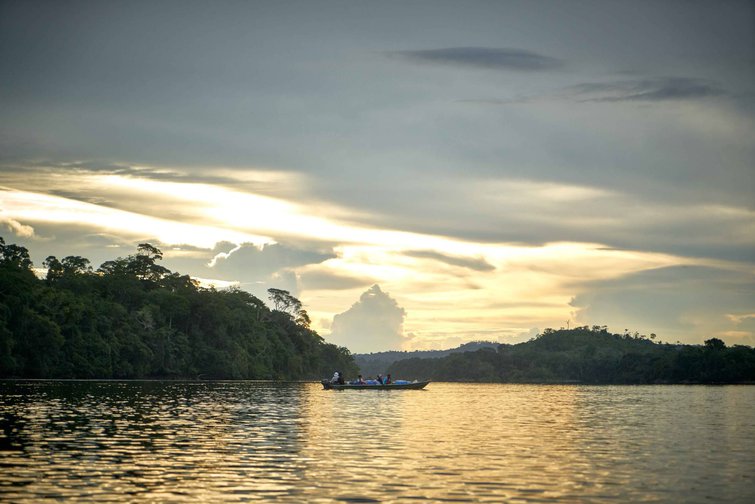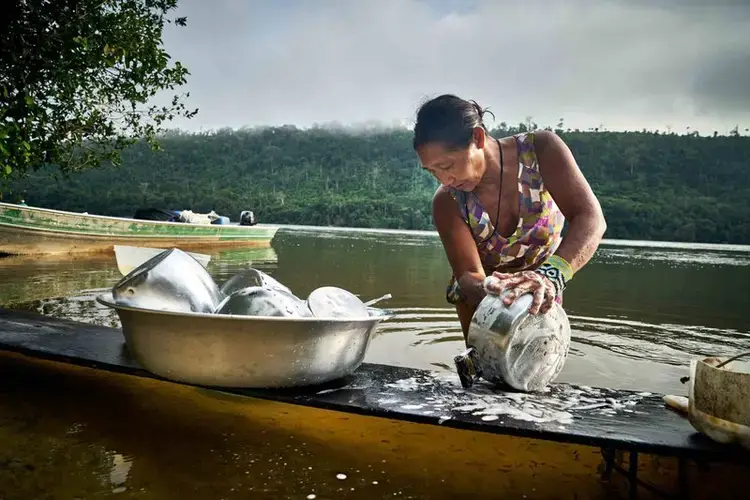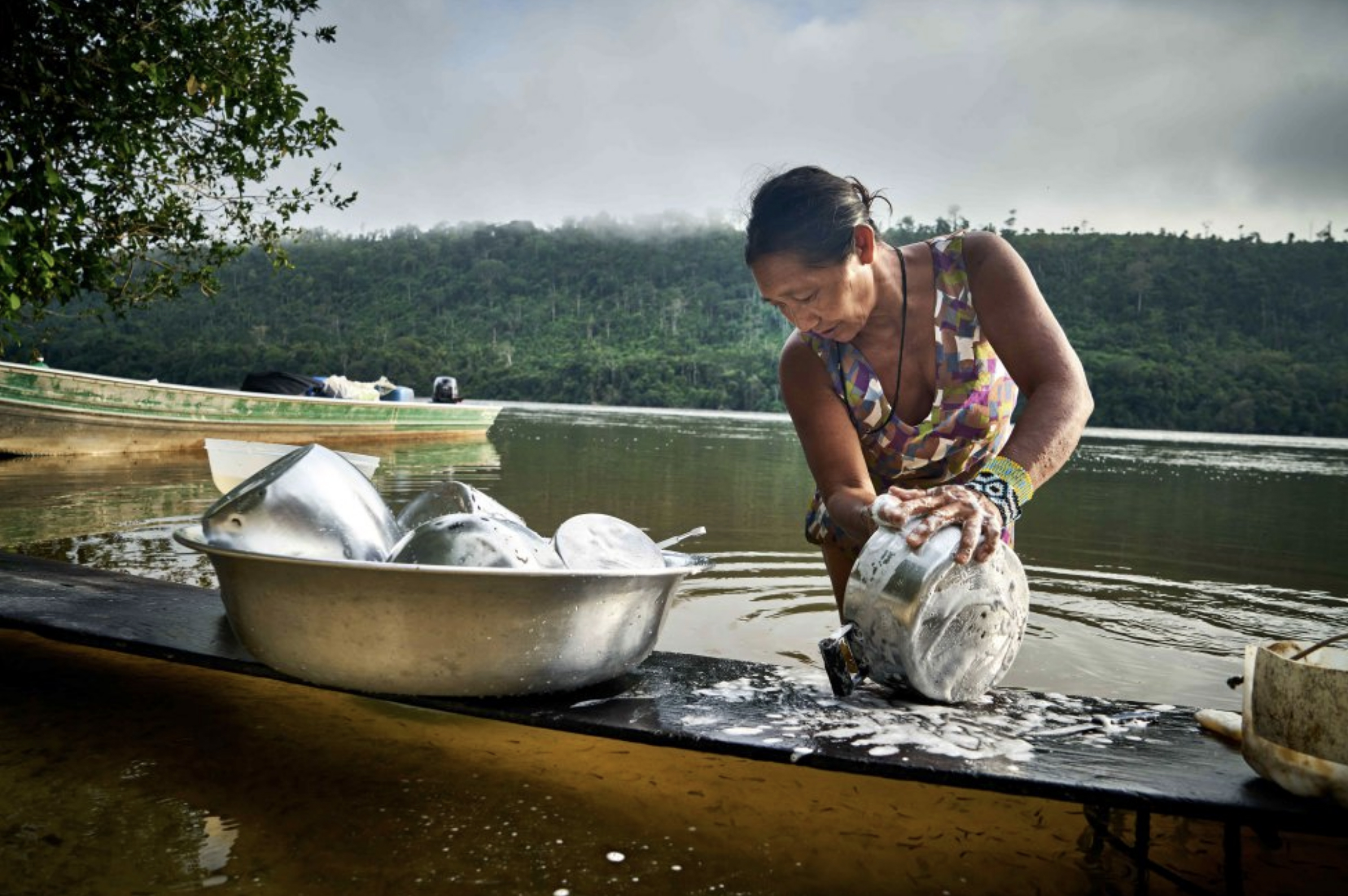
“My life is defending this place” says Eduardo Morimã, a native to the apiaka ethnic group who lives in the village of Mayrob, in the municipality of Juara, in north of the Brazilian state Mato Grosso. Situated in the heart of the country, it is one of the main eyes on the hurricane of deforestation in the Amazon rainforest as a result of intensive cattle ranching and the monocultures of soy, corn and cotton that have created an agricultural belt in the South of the Amazon.
The impact building hundreds of hydroelectricity plants will have goes beyond impacting the flora and fauna of the river and displacing populations but will also aggravate deforestation rates in the region.
“I spend my life traveling, I only stay in a home for about 5 days a month. Luckily, my children are older” adds Morimã, he is completely dedicated to the defense of the environment. Morimã wakes up in a different place every day, but always with the objective of informing neighbouring villages and towns about the building of the Castanheria hydroelectricity plant on the Arionos river, in the municipality of Juara. This river is in the lower part of the Juruena river basin and flows into Tapajós river until it reaches the mighty Amazon.
The Castanheira plant is classified as a large hydroelectric producer (UHE), that is, it can dispense more than 30 megawatts. It is part of a project whereby several companies intend to build 138 small, medium and large energy generating stations in the Juruena river basin of the Amazon, a region with immense hydroelectric power but that still remains relatively free of dams. In the basin, currently there are 32 functioning hydroelectricity plants and 10 currently under construction.
The People Want To Be Consulted
“The plan for the Juruena river basin is to transform rivers into sources of electrical production. The discussion is about natural or economic resources?” says Jefferson Nasimento, the coordinator of Movimento dos Atingidos por Barragens (MAB) , an organisation which aims to protect people whose lives have been affected by damming. “Castanheira would be the gateway to completely alter the area and transform it into a mega hydroelectric complex” according to data found by MAB, which has worked to monitor the impacts of different types of dams since the 1970s, when the Itaipú plant was built in Brazil, one of the largest in the world.
Nascimento believes the proposal of the current central government could increase human rights violations because of the failure to acknowledge certain risks. The current president Jair Bolsonaro has stated during his election campaign that if it was up to him, he would not demarcate another centimetre of indigenous land or natural reserves as these types of land shouldn’t hinder the development of a country rich in natural resources.
The Minister of the Environment, Ricardo Salles, expressed that at the start of his time in office that wished to streamline environmental licensing processes so that projects such as the construction of hydroelectricity plants did not take so long to get off the ground.
"Faced with the desire for a consultation by the populations who are both directly and indirectly affected, the Energy Research Company, who are responsible for the project, responded claiming that organizing a consultation was not one of its responsibilities."
“The people have to be informed and consulted and in the consultation process they have the right to say no to hydroelectricity,” argues Nascimento who explains how on innumerable occasions some projects have breached the agreement to have a free and informed consultation with the affected people as is stipulated in Convention 169 of the international labour organisation on Indigenous and tribal people. A requirement that is also included in the Brazilian constitution.
Faced with the desire for a consultation by the populations who are both directly and indirectly affected, the Energy Research Company (EPC, its acronym in Portuguese), who are responsible for the project, responded claiming that organising a consultation was not one of its responsibilities. “Convention 169 is only intended for Indigenous and tribal people,” explains Lieggio. “There is no consultation process, we have already held meetings with Indigenous people (…).
In 2016 they gave authorisation for us to collect primary information from their land”, adds the deputy superintendent of EPC who explains that there will be a National Indian Foundation (FUNAI), which will show, if according to their studies about the Indigenous population, whether the investment is viable considering the native communities.
Looking For Ways To Develop Without Wasting Resources
“The local populations would not receive any of this energy. They would simply be left with the damages,” claims Nascimento who denounces the economic infeasibility of the millionaire investment. “We need to look for another way to develop that is not based on the predatory extraction of resources. We are experiencing the process of neo-colonialism, the owners of the majority of hydroelectric plants are companies based in France, Portugal, Spain, China, or the United States”, he explains. The Castanheria station could generate, according to the projections of EPE, a power 140 megawatts, of which 98% would be used and discharged into the National Energy System of Brazil. This amount of electricity doesn’t even represent 1% of the total consumption in the state of Mato Grosso, it is an even less significant amount when you consider that Brazil already has energy excess of almost 14,000 megawatts, according to 2017 data from ENGIE Brasil Energia S.A.
Guilherme Fialho, energy research analysts of EPE, argues that the increase in energy would stabilise the energy system and reduce the chance of blackouts. “The country is growing, and we are going to need energy expansion,” adds Fialho. “To meet the expected growth in consumption, it's essential to build more power plants in the country,” the environmental report for this dam emphases. In another collaborative report, the EPE also argues that one of the challenges from Castanheira is “to make the expansions of agribusinesses compatible with the preservation of the environment. “Argobusiness is fairly common in the state of Mato Grosso (…). We cannot ignore the importance of this to the national GDP,” adds the company in said document.
In the 10-year energy extension plan prepared by the EPE, a moderate growth in the Brazilian economy is predicted. “Mining will be the fastest growing sector (…). The Brazilian mining industry is very competitive thanks to its high volume of superior quality minerals”, explains the 10-year plan, which highlights the potential for iron and oil extraction. Glauce Lieggio, from the EPE, explains that it is impossible to know how much energy each sector of the economy requires and some sectors, mining, for example, have their own power plants.
If the Castanheira hydroelectric project gets off the ground it will destroy villages in three riverside municipalities.
Brazil has 160 million kilowatts worth of power. According to the latest data from ANEEL (accessed on the 25th May 2019), there are 1,345 hydroelectric plants that are small, medium, or large and are responsible for 64% of the energy generated in the country. Beyond the water resources, thermoelectric plants produce 24.5% of the total energy, wind energy produces 9.1%, thermonuclear 1.2% and solar photovoltaic 1.3%.
If the building of the Castanheira gets off the ground, “ the reservoir would flood an area of 9,470 hectares affecting land in both the municipality of Juara and Novo Horizonte do Norte,” as stated in the environmental impact report carried out by Habtec Mott MacDonald—A NovoTerra consortium for the EPE. 99% of the flooded area would be in in the municipal are of Juara. “The municipality of Porto dos Gauchos is further away, and the works might not affect the urban or rural areas (…). We have identified all the affected properties in a list," explains Elisângela Medeiros de Almeida, superintendent of the economic, energy, and environmental studies, which has an informative website about the Castanheria project.

The affected communities were given more information about the project on the 28th of February, when the first public hearing was, organised by the Federal Public Ministry and the Public Ministry for the State of Mato Grosso. The EPE was not invited to the meeting and claimed to not know why. The company has said that the public hearing for the environmental licensing process will be announced by the Secretary of State for the Environment of Mato Grosso, although no dates for this have been confirmed yet.
The Arinos river, where the plant is expected to be built, is already suffering because of the soy and sugar cane monocultures close by, and as such, is included in the study of the environmental impacts on hydroelectric plants in Juruena river basin, which has been carried out by the company itself. The region has already lost a considerable number of natural habitats due to the agricultural expansion and the mineral extraction. However, it continues to be one of the rivers with the greatest amount of diversity and number of fishes, with around 146 species identified, which the researchers admitted might be an underestimate. They also found 800 species of wildlife according to the document.
Bolsonaro already confirmed during his electoral campaign that the Indigenous lands, as well as the natural reserves, cannot hinder the development of the country.
“Castanheira doesn’t directly interfere with environmental conservation units or Indigenous lands, so the construction of this plants is less conflictive,” De Alemeida said in an interview. Although the lands of the apiaka, rikbaktsa, kaiabi, munduruku, tapayuna, and other Indigenous groups that remain are isolated today, the building of a hydroelectric plant 120 kilometres from the source of the river would affect the migratory flows of fish.
The nearby communities rely on these not only for food but all also for their scared rituals. “The impact would be irreparable, there’s not enough money to make up for that,” acknowledges this leader of apiaka people as he lists destruction as an impact of other hydroelectric projects that he has visited in other regions of Brazil, such as Belo Monte or Teles Pires.
“In 2000, I was in a village near the Teles Pires river and there was an abundance of fish, and now you have to travel two or three hours by boat to other rivers in order to be able to fish. The river near our village is so small that the dam could even dry it up”, he adds.
When asked about the concerns of the Indigenous people, the EPE alleged that its strategy was to simply compensate people with money. “We are trying to maintain the availability of these resources,” says Glauce Lieggio, deputy superintendent of this company. EPE says it is considering different methods to “mitigate the impacts on resources”. Among them is a system of transfer to species which aims “to guarantee a long-term fish population,” explains Marianna Especie, a research analyst of the company.
The study also states that “the Castanheria plant would be located in the region considered the most important seismic zone of Brazil, called the seismic zone of Porot dos Gaúchos (ZSPG)”. Accidents in these types of facilities are common. Last year 3 small hydroelectric plants in the Arinos river broke leading to evacuation of the riverside population.
“They are overwhelming large projects that could end our culture, alongside the wildlife and our lives in general,” says Morimã, who says thanks to a demonstration in 1989 they managed to stop the building of dam that was almost built 5 kilometres from the del Salto Sagrado dos Kaiabi, one of the most emblematic places for apiaka people who live close by. “It is a beautiful waterfall; every weekend Indigenous people go there to hunt and fish. We do not want to see it destroyed.” Morimã adds that without nature he believes that his community would get sick.
Amaral, from FUNAI, explains that the compensation that is offered to affected communities does not resolve their genuine needs and he considers it an “unjust exchange”. When asked about the Castanheira project Amaral responded saying that it was the only project that doesn’t flood any indigenous lands directly, but it would still limit the biodiversity and would affect the ecological flow on which these communities depend on.
“What is at stake at the moment is the risk of further plants which are being planned in the region. Castanheira is a test to prepare for the rest of the negations,” adds this representative of the governmental organ of FUNAI, who adds that they would certainly be immeasurable impacts to the ancestral people, who currently live in an isolated way in the region.








